Rick Just's Blog, page 86
August 18, 2022
Stewart Hoover (Tap to read)
Stewart W. Hoover was born on Independence Day, 1895 in Montpelier, Idaho. When he was 10 his father, Dr. Clayton A. Hoover was named Medical Superintendent of the Idaho State Insane Asylum, so the family moved to Blackfoot.
Stewart enjoyed his new life in Blackfoot, a place that allowed him to ride horses, hunt, take nature walks with his dog, and play basketball. He was well liked in school, where he studied hard and became his class valedictorian when he graduated from Blackfoot High in 1911.
Hoover applied for the United States Military Academy at West Point, New York, was accepted, and began his studies there in 1913. At the Academy he was among many serious students and kept himself in the background for the most part. One exception was when he saved a child from drowning in nearby Lusk Reservoir. Stewart Hoover graduated in 1917 as a second lieutenant and was quickly promoted to first lieutenant.
By June 29, Hoover was in France. He was named a temporary captain of infantry on August 5, 1917.
In the spring of 1918, his family received a dreadful announcement, which began, “I have the honor to inform you that Captain Stewart W. Hoover of Company "I", Eighteenth Infantry, was killed in battle on March 1st. There is no officer in this regiment who has had a better record for gallantry than Captain Hoover and he was killed at the head of his company during a desperate encounter with German storm troops.”
Hoover met his end when a German shell exploded near where he was standing with a gun leveled at the enemy. He was the first soldier from Idaho to die in World War I, and the first West Point officer to die in that gruesome war.
Two American Legion posts are today named in his honor, one at West Point and the other in Blackfoot.
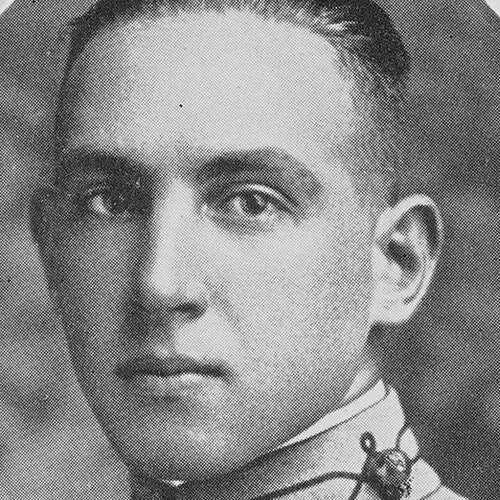
Stewart enjoyed his new life in Blackfoot, a place that allowed him to ride horses, hunt, take nature walks with his dog, and play basketball. He was well liked in school, where he studied hard and became his class valedictorian when he graduated from Blackfoot High in 1911.
Hoover applied for the United States Military Academy at West Point, New York, was accepted, and began his studies there in 1913. At the Academy he was among many serious students and kept himself in the background for the most part. One exception was when he saved a child from drowning in nearby Lusk Reservoir. Stewart Hoover graduated in 1917 as a second lieutenant and was quickly promoted to first lieutenant.
By June 29, Hoover was in France. He was named a temporary captain of infantry on August 5, 1917.
In the spring of 1918, his family received a dreadful announcement, which began, “I have the honor to inform you that Captain Stewart W. Hoover of Company "I", Eighteenth Infantry, was killed in battle on March 1st. There is no officer in this regiment who has had a better record for gallantry than Captain Hoover and he was killed at the head of his company during a desperate encounter with German storm troops.”
Hoover met his end when a German shell exploded near where he was standing with a gun leveled at the enemy. He was the first soldier from Idaho to die in World War I, and the first West Point officer to die in that gruesome war.
Two American Legion posts are today named in his honor, one at West Point and the other in Blackfoot.

Published on August 18, 2022 09:00
August 17, 2022
The Idaho Scimitar (Tap to read)
I’ve written before about Fred T. Dubois, fiery U.S. Senator from Idaho 1891-1897, and 1901-1907. He was a zealot about polygamy when he was U.S. Marshall for Idaho from 1882 to 1884, and continued his opposition in his national office. His anti-Mormonism was one reason Idaho Democrats lost the Legislature in 1907, which was why Dubois lost his seat. The newly elected Republican majority Legislature booted Dubois (this was when legislatures named U.S. Senators) and elected William Borah to replace him.
One little-remembered attempt to gin up more anti-Mormon sentiment was a newspaper he started in Boise, called The Idaho Scimitar. It published weekly on Saturdays, beginning with the November 2nd issue in 1907. Its aim was “the moral uplift of the people everywhere.” Advertisers were few. Most notably, in addition to anti-Mormon screeds, the paper published numerous notices about public lands opened up for settlement.
In the final issue of The Idaho Scimitar, on October 3, 1918, Dubois lamented the paper’s end, giving one more stab to the Mormons: “This immediate section of the great Rocky mountain country, Utah, Wyoming and Idaho, is controlled by the Mormon organization politically. To my mind this polygamous and law-defying order is the greatest menace to our immediate civilization.”
His vitriol was not reserved solely for Mormons. He had little use for Indians, particularly Bannocks. In an 1895 article in the New York Times, he was quoted as saying, “The extermination of the whole lazy, shiftless, non-supporting tribe of Bannocks would not be any great loss.” His national office also gave him the opportunity to pass judgement on Filipinos, Hawaiians and “the American negro” in the Congressional Record, decrying their alleged lack of a work ethic.

One little-remembered attempt to gin up more anti-Mormon sentiment was a newspaper he started in Boise, called The Idaho Scimitar. It published weekly on Saturdays, beginning with the November 2nd issue in 1907. Its aim was “the moral uplift of the people everywhere.” Advertisers were few. Most notably, in addition to anti-Mormon screeds, the paper published numerous notices about public lands opened up for settlement.
In the final issue of The Idaho Scimitar, on October 3, 1918, Dubois lamented the paper’s end, giving one more stab to the Mormons: “This immediate section of the great Rocky mountain country, Utah, Wyoming and Idaho, is controlled by the Mormon organization politically. To my mind this polygamous and law-defying order is the greatest menace to our immediate civilization.”
His vitriol was not reserved solely for Mormons. He had little use for Indians, particularly Bannocks. In an 1895 article in the New York Times, he was quoted as saying, “The extermination of the whole lazy, shiftless, non-supporting tribe of Bannocks would not be any great loss.” His national office also gave him the opportunity to pass judgement on Filipinos, Hawaiians and “the American negro” in the Congressional Record, decrying their alleged lack of a work ethic.

Published on August 17, 2022 04:00
August 16, 2022
Miss Idaho Makes Good (Tap to read)
Judy Lynn was a country star you didn’t hear much on the radio. Born Judy Lynn Voiten in Boise in 1936, she was just a teenager when she joined a touring company of the Grand Ole Opry. At 19, in 1955, she was crowned Miss Idaho.
Lynn put out 14 albums and 47 singles. Only four of the singles cracked the country charts, with 1962’s “Footsteps of a Fool” doing the best, peaking at number seven.
But radio wasn’t Judy Lynn’s venue. Vegas was. She had her own show on The Strip for more than 20 years .

Lynn put out 14 albums and 47 singles. Only four of the singles cracked the country charts, with 1962’s “Footsteps of a Fool” doing the best, peaking at number seven.
But radio wasn’t Judy Lynn’s venue. Vegas was. She had her own show on The Strip for more than 20 years .

Published on August 16, 2022 04:00
August 15, 2022
Kook's Tour (Tap to read)
There is little neutral ground when it comes to the Three Stooges. You either love them or, not so much. I’m in the not-so-much category, but I was intrigued to learn that their last movie was filmed partly in Idaho.
Larry Fine and Moe Howard started their long and wacky careers as a vaudeville act in 1922 with Shemp Howard as the third leg of the comedy stool. That “leg” was also played by Curly Howard, Joe Besser, and “Curley” Joe Derita over the years, according to the elves at Wikipedia. They made 190 short films that are probably still playing somewhere 24 hours a day.
The Stooges, known for their unique and violent form of slapstick comedy, were trying to launch a new stage in their career in 1969. They were going to do a series of travel “documentaries” set in various locations. Is this where Rick Steves got his idea? Probably not.
During their travels knucklehead antics would ensue. The pilot of the series was called Kook’s Tour, which was a play on the Thomas Cook Travel agency’s Cook’s Tours, recently in the news because they shut down and left travelers stranded. It was shot mostly in Idaho and Wyoming. Filming was not yet complete when Larry Fine suffered a stroke, paralyzing the left side of his body. That killed the idea of a comic travel series.
Someone eventually pulled together the footage they had shot for the pilot and released it as a short movie in 1975. It would be the last film of the Three Stooges’ long career.

Larry Fine and Moe Howard started their long and wacky careers as a vaudeville act in 1922 with Shemp Howard as the third leg of the comedy stool. That “leg” was also played by Curly Howard, Joe Besser, and “Curley” Joe Derita over the years, according to the elves at Wikipedia. They made 190 short films that are probably still playing somewhere 24 hours a day.
The Stooges, known for their unique and violent form of slapstick comedy, were trying to launch a new stage in their career in 1969. They were going to do a series of travel “documentaries” set in various locations. Is this where Rick Steves got his idea? Probably not.
During their travels knucklehead antics would ensue. The pilot of the series was called Kook’s Tour, which was a play on the Thomas Cook Travel agency’s Cook’s Tours, recently in the news because they shut down and left travelers stranded. It was shot mostly in Idaho and Wyoming. Filming was not yet complete when Larry Fine suffered a stroke, paralyzing the left side of his body. That killed the idea of a comic travel series.
Someone eventually pulled together the footage they had shot for the pilot and released it as a short movie in 1975. It would be the last film of the Three Stooges’ long career.

Published on August 15, 2022 04:00
August 14, 2022
Dr. Friedline (Tap to read)
I found the picture below of an early Boise dentist intriguing while skimming through the massive photo collection of Hugh Hartman, so I decided to do a little digging on the dentist, Dr. Abraham Friedline.
One of the first things I found was that the doctor did a little digging himself. In addition to his dental duties he was the president of the X-Ray Mine, eight miles from Boise in the Black Hornet mining district near the town of Pearl. In his vision the X-Ray would be a mile-and-a-half tunnel through veins of quartz that would make him fabulously wealthy. Others could buy into the mine for 25 cents a share in 1903. The Statesman reported on progress in the mine for a couple of years, and on the trial of a man who had shot the mine manager to death while the manager was walking to work. The stories petered out, much as the gold in the mines near Pearl did after a few years.
But there was more than mining to Dr. Friedline. He was also a local real estate developer. The Statesman reported in 1902 that he was building “a handsome row of houses” on the northeast corner of 14th and State in Boise. The eight houses were to be two stories in height, each having six rooms, with closets, pantry, storeroom, baths, etc. Each pair of houses, built with adjoining walls, would have neat porticos over their entrance. The whole block would be made of brick and stone.
What would be first known as Friedline Terraces, would soon become called Friedline Flats. Those buildings are still in use today as apartments, the western side of which are across from the Fanci Freeze drive in.
It was his dental practice that drew me into the story. The photo shows just how popular busy wallpaper was at the time, not to mention hardworking flooring and a ceiling that was positively hectic. Overlooking it all as if he had accidentally rammed his head through the wall and stayed there, stunned to stone by the decor, was an eight-point buck with a bandana tied around his neck. He may have been there as a reminder to patients under the drill at Denver Dental that things could be worse.
Dr. Friedline passed away in 1914 at the age of 66. His two sons, who had also become dentists, took over the practice.
Mrs. Friedline, a lovely woman, held a special place in her father’s heart. He was sure she would be a pal to him, so he named her that. Apal. Hugh Hartman, who generously supplied the photos for this story, was a friend of hers in later years. He remembered that when Apal was in her eighties she suddenly got a hankering for world travel. She asked him if he would take care of selling a 63-piece sterling silver service so she could take a spin around the globe. Hugh talked the manager of the Mode into putting the set in the popular department store’s display window, and soon Apal Friedline was seeing the sites she’d always dreamed of seeing. By all accounts, the deer stayed in Boise.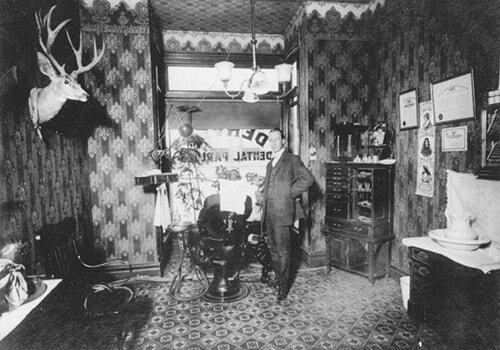
Dr. Abraham Friedline poses next to his patient chair at the Denver Dental office circa 1910.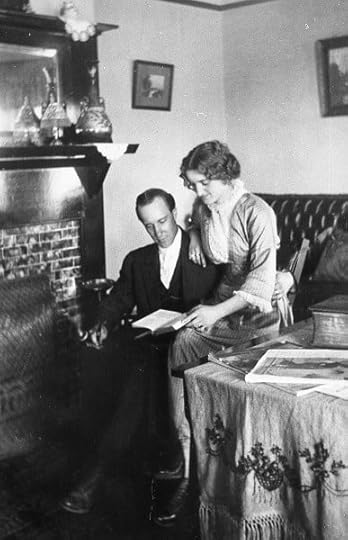 Dr. Friedline and his wife Apal in their home, which was on the corner of Washington and 14th, not far from Denver Dental.
Dr. Friedline and his wife Apal in their home, which was on the corner of Washington and 14th, not far from Denver Dental. 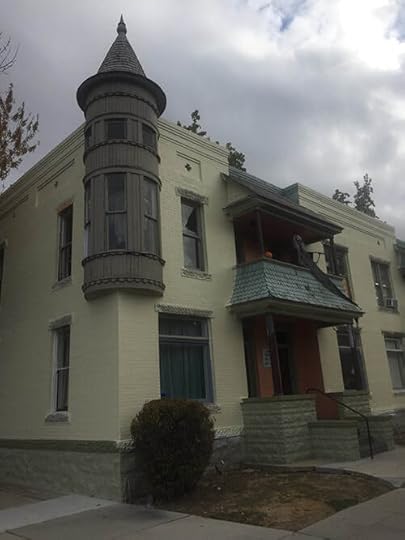 A contemporary photo of Friedline Flats on State Street at 14th.
A contemporary photo of Friedline Flats on State Street at 14th.
One of the first things I found was that the doctor did a little digging himself. In addition to his dental duties he was the president of the X-Ray Mine, eight miles from Boise in the Black Hornet mining district near the town of Pearl. In his vision the X-Ray would be a mile-and-a-half tunnel through veins of quartz that would make him fabulously wealthy. Others could buy into the mine for 25 cents a share in 1903. The Statesman reported on progress in the mine for a couple of years, and on the trial of a man who had shot the mine manager to death while the manager was walking to work. The stories petered out, much as the gold in the mines near Pearl did after a few years.
But there was more than mining to Dr. Friedline. He was also a local real estate developer. The Statesman reported in 1902 that he was building “a handsome row of houses” on the northeast corner of 14th and State in Boise. The eight houses were to be two stories in height, each having six rooms, with closets, pantry, storeroom, baths, etc. Each pair of houses, built with adjoining walls, would have neat porticos over their entrance. The whole block would be made of brick and stone.
What would be first known as Friedline Terraces, would soon become called Friedline Flats. Those buildings are still in use today as apartments, the western side of which are across from the Fanci Freeze drive in.
It was his dental practice that drew me into the story. The photo shows just how popular busy wallpaper was at the time, not to mention hardworking flooring and a ceiling that was positively hectic. Overlooking it all as if he had accidentally rammed his head through the wall and stayed there, stunned to stone by the decor, was an eight-point buck with a bandana tied around his neck. He may have been there as a reminder to patients under the drill at Denver Dental that things could be worse.
Dr. Friedline passed away in 1914 at the age of 66. His two sons, who had also become dentists, took over the practice.
Mrs. Friedline, a lovely woman, held a special place in her father’s heart. He was sure she would be a pal to him, so he named her that. Apal. Hugh Hartman, who generously supplied the photos for this story, was a friend of hers in later years. He remembered that when Apal was in her eighties she suddenly got a hankering for world travel. She asked him if he would take care of selling a 63-piece sterling silver service so she could take a spin around the globe. Hugh talked the manager of the Mode into putting the set in the popular department store’s display window, and soon Apal Friedline was seeing the sites she’d always dreamed of seeing. By all accounts, the deer stayed in Boise.

Dr. Abraham Friedline poses next to his patient chair at the Denver Dental office circa 1910.
 Dr. Friedline and his wife Apal in their home, which was on the corner of Washington and 14th, not far from Denver Dental.
Dr. Friedline and his wife Apal in their home, which was on the corner of Washington and 14th, not far from Denver Dental.  A contemporary photo of Friedline Flats on State Street at 14th.
A contemporary photo of Friedline Flats on State Street at 14th.
Published on August 14, 2022 04:00
August 13, 2022
The Fish Inn (Tap to read)
Unique is a word that needs no modifier since it means “unlike anything else.” One thing can’t be more unique than another thing. That doesn’t stop people from sticking words such as “totally,” “really,” “completely,” and “very” in front of unique. Nowadays its meaning is all but synonymous with “unusual.” Language changes and words get watered down. Insert sigh here.
This minor rant comes about because the word “unique” fit the Fish Inn better than any other word. If there was another building remotely like this one, I’m unaware of it. It looked like a fish, more or less. You entered through the gaping mouth. The body of the fish was covered with shingles made to look like scales. The tail, as the only flat part of the fish, became a sign.
The restaurant was built in 1932 for Kenny and Mamie West on Highway 10 near Wolf Lodge Bay. The look of the thing would lead one to believe that they served fish there. They did. Not exclusively, though. For instance, they served adult beverages. In later years you could have a burger and listen to the Normal Fishing Tackle Band. It was once voted one of the best road bars in America by Road and Track magazine.
You could also tack a dollar bill to the ceiling. That not-unique tradition started when a customer proposed to his girlfriend on a dollar bill. She is said to have written “yes,” also on a dollar.
There were something like 4,000 dollar bills tacked to the ceiling at one time. Unfortunately, no one had taken them to the bank when the bills, and the restaurant, burned in 1996.

This minor rant comes about because the word “unique” fit the Fish Inn better than any other word. If there was another building remotely like this one, I’m unaware of it. It looked like a fish, more or less. You entered through the gaping mouth. The body of the fish was covered with shingles made to look like scales. The tail, as the only flat part of the fish, became a sign.
The restaurant was built in 1932 for Kenny and Mamie West on Highway 10 near Wolf Lodge Bay. The look of the thing would lead one to believe that they served fish there. They did. Not exclusively, though. For instance, they served adult beverages. In later years you could have a burger and listen to the Normal Fishing Tackle Band. It was once voted one of the best road bars in America by Road and Track magazine.
You could also tack a dollar bill to the ceiling. That not-unique tradition started when a customer proposed to his girlfriend on a dollar bill. She is said to have written “yes,” also on a dollar.
There were something like 4,000 dollar bills tacked to the ceiling at one time. Unfortunately, no one had taken them to the bank when the bills, and the restaurant, burned in 1996.

Published on August 13, 2022 04:00
August 12, 2022
Bison Jumps (Tap to read)
Bison jumps, or buffalo jumps, if you prefer, were an efficient way for the people indigenous to North America to obtain food in quantities not available in any other way. Several sites in the plains and in Montana are more famous and better studied, but Idaho has a bison jump that is worth a visit.
The Challis Bison Jump site is on property managed by the Bureau of Land Management near the visitor center for Land of the Yankee Fork State Park, which is just south of Challis at the junction of US 93 and State Highway 75.
How the Shoshoni drove the bison to the precipice may have varied. Before the arrival of horses tribal members probably snuck up on a herd on foot on three sides, making themselves known when they were close enough to startle the beasts, driving them forward and over the cliff. But they may also have used a “lure.”
Meriwether Lewis, writing in his journals about the method of Blackfeet Indians in present-day Montana, wrote, “one of the most active and fleet young men is selected and disguised in a robe of buffalo skin... he places himself at a distance between a herd of buffalo and a precipice proper for the purpose; the other Indians now surround the herd on the back and flanks and at a signal agreed on all show themselves at the same time moving forward towards the buffalo; the disguised Indian or decoy has taken care to place himself sufficiently near the buffalo to be noticed by them when they take to flight and running before them they follow him in full speed to the precipice; the Indian (decoy) in the mean time has taken care to secure himself in some cranny in the cliff... the part of the decoy I am informed is extremely dangerous.”
The Shoshoni may have used the Challis jump site for centuries, though by 1840 the bison were mostly gone. Once plains Indians acquired horses they began to prefer the method of surrounding the animals and running them in a circle while stabbing the beasts with long lances.
Some bison jump sites have yielded bones twenty and thirty feet deep indicating long use. Many bones have been excavated at the Challis site, though not nearly to that extent. Stone weapons and sites where they were made are also associated with the Challis Bison Jump. It was placed on the National Register of Historical Places in 1975.
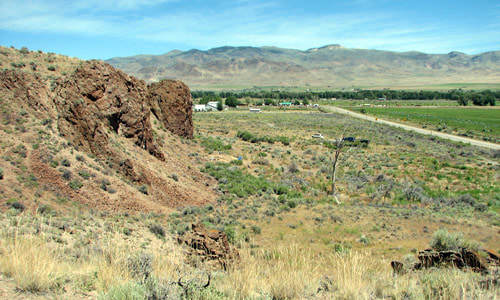 The Bison Jump site near Challis.
The Bison Jump site near Challis.
The Challis Bison Jump site is on property managed by the Bureau of Land Management near the visitor center for Land of the Yankee Fork State Park, which is just south of Challis at the junction of US 93 and State Highway 75.
How the Shoshoni drove the bison to the precipice may have varied. Before the arrival of horses tribal members probably snuck up on a herd on foot on three sides, making themselves known when they were close enough to startle the beasts, driving them forward and over the cliff. But they may also have used a “lure.”
Meriwether Lewis, writing in his journals about the method of Blackfeet Indians in present-day Montana, wrote, “one of the most active and fleet young men is selected and disguised in a robe of buffalo skin... he places himself at a distance between a herd of buffalo and a precipice proper for the purpose; the other Indians now surround the herd on the back and flanks and at a signal agreed on all show themselves at the same time moving forward towards the buffalo; the disguised Indian or decoy has taken care to place himself sufficiently near the buffalo to be noticed by them when they take to flight and running before them they follow him in full speed to the precipice; the Indian (decoy) in the mean time has taken care to secure himself in some cranny in the cliff... the part of the decoy I am informed is extremely dangerous.”
The Shoshoni may have used the Challis jump site for centuries, though by 1840 the bison were mostly gone. Once plains Indians acquired horses they began to prefer the method of surrounding the animals and running them in a circle while stabbing the beasts with long lances.
Some bison jump sites have yielded bones twenty and thirty feet deep indicating long use. Many bones have been excavated at the Challis site, though not nearly to that extent. Stone weapons and sites where they were made are also associated with the Challis Bison Jump. It was placed on the National Register of Historical Places in 1975.
 The Bison Jump site near Challis.
The Bison Jump site near Challis.
Published on August 12, 2022 04:00
August 11, 2022
Anse de Biche (Tap to read)
We never know where Idaho history will take us. Today’s post starts with TV personality Hasan Minhaj and ends with a French lesson.
Minhaj had a Netflix program called “Patriot Act with Hasan Minhaj” that took a quirky, comedic look at topics of the day. As a supplement to the program he had a YouTube channel where he did the same thing in a shorter format. There he posted a program called What's With The Racist Names Of So Many American Places? He pointed out that names can be changed. His focal point was Negro Point in New York City. He mentioned the (USBGN) is the place to go if you want to get a place name changed. They make the final decision on most, but not all, names you see on a map.
Full disclosure, I serve on the Idaho Geographical Names Advisory Committee (IGNAC). We have zero power when it comes to place names, but we do review proposals to name features or change existing names in Idaho that USBGN has received. We make our recommendations to the Board of Trustees of the Idaho State Historical Society to approve or deny a proposal based on USBGN . They then decide whether to follow our recommendation or go their own way. The board then sends its recommendation to USBGN, which makes the final decision.
It is difficult to get a name changed. It should be. If names changed frequently it would lead to all kinds of cartographic confusion. There is a process one can follow and you can begin it by following the links above.
Minhaj—remember Minhaj up there in the beginning of this story? —stirred up quite a bit of interest in changing names that are racially offensive. Several groups took on the challenge and began efforts to change some of those names. In today’s internet-dominated world many of them thought gathering names on petitions was a great idea. That isn’t going to work. There is a process that anyone can follow, and it doesn’t involve petitions. It’s not a popularity contest.
Which brings us to the French lesson. One of those petitions included an Idaho place name that some thought offensive, though not racially offensive. Bitch Creek was declared a derogatory name toward women by the petitioner. About 60 people nationwide agreed with the petitioner and asked for a name change. If they really want to change it, they’ll need to go through the aforementioned process, even if they get a few thousand more names on their petition.
Bitch Creek starts in Wyoming, flows into Idaho forming the border between Fremont and Teton counties until it converges with Badger Creek, which in turn flows into the North Fork of the Teton River. We could follow its waters to the Pacific Ocean, but you probably get the picture. According to Lalia Boone’s book Idaho Place Names, A Geographical Dictionary , the original name was Anse de Biche, given to the creek by French trappers. “Anse” can mean “handle” or “cove,” the latter being more likely. “Biche” means “doe” in French.
Biche was corrupted over the years to Bitch. No doubt many have assumed that was meant to be disparaging and many have probably used it in that way. Never mind the canine term, which is the first definition of the word in English.
So, the French trappers who named the stream Bitch Creek probably did so innocently. Not so with the name of the nearby Teton Mountains, which were originally Les Trois Tetons, or The Three Breasts. Some petitioner will probably find that offensive, too. But that’s Wyoming’s issue to deal with.
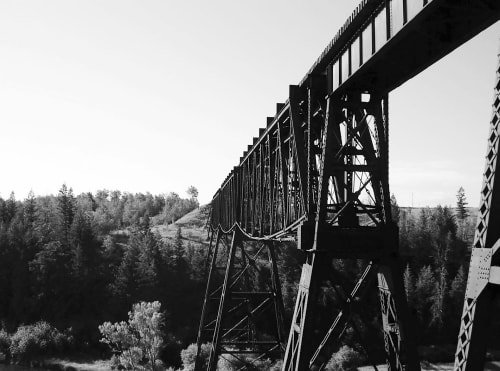 Bitch Creek Trestle is part of the Ashton-Tetonia Trail operated by the Idaho Department of Parks and Recreation. It crosses 150 feet above Bitch Creek.
Bitch Creek Trestle is part of the Ashton-Tetonia Trail operated by the Idaho Department of Parks and Recreation. It crosses 150 feet above Bitch Creek.
Minhaj had a Netflix program called “Patriot Act with Hasan Minhaj” that took a quirky, comedic look at topics of the day. As a supplement to the program he had a YouTube channel where he did the same thing in a shorter format. There he posted a program called What's With The Racist Names Of So Many American Places? He pointed out that names can be changed. His focal point was Negro Point in New York City. He mentioned the (USBGN) is the place to go if you want to get a place name changed. They make the final decision on most, but not all, names you see on a map.
Full disclosure, I serve on the Idaho Geographical Names Advisory Committee (IGNAC). We have zero power when it comes to place names, but we do review proposals to name features or change existing names in Idaho that USBGN has received. We make our recommendations to the Board of Trustees of the Idaho State Historical Society to approve or deny a proposal based on USBGN . They then decide whether to follow our recommendation or go their own way. The board then sends its recommendation to USBGN, which makes the final decision.
It is difficult to get a name changed. It should be. If names changed frequently it would lead to all kinds of cartographic confusion. There is a process one can follow and you can begin it by following the links above.
Minhaj—remember Minhaj up there in the beginning of this story? —stirred up quite a bit of interest in changing names that are racially offensive. Several groups took on the challenge and began efforts to change some of those names. In today’s internet-dominated world many of them thought gathering names on petitions was a great idea. That isn’t going to work. There is a process that anyone can follow, and it doesn’t involve petitions. It’s not a popularity contest.
Which brings us to the French lesson. One of those petitions included an Idaho place name that some thought offensive, though not racially offensive. Bitch Creek was declared a derogatory name toward women by the petitioner. About 60 people nationwide agreed with the petitioner and asked for a name change. If they really want to change it, they’ll need to go through the aforementioned process, even if they get a few thousand more names on their petition.
Bitch Creek starts in Wyoming, flows into Idaho forming the border between Fremont and Teton counties until it converges with Badger Creek, which in turn flows into the North Fork of the Teton River. We could follow its waters to the Pacific Ocean, but you probably get the picture. According to Lalia Boone’s book Idaho Place Names, A Geographical Dictionary , the original name was Anse de Biche, given to the creek by French trappers. “Anse” can mean “handle” or “cove,” the latter being more likely. “Biche” means “doe” in French.
Biche was corrupted over the years to Bitch. No doubt many have assumed that was meant to be disparaging and many have probably used it in that way. Never mind the canine term, which is the first definition of the word in English.
So, the French trappers who named the stream Bitch Creek probably did so innocently. Not so with the name of the nearby Teton Mountains, which were originally Les Trois Tetons, or The Three Breasts. Some petitioner will probably find that offensive, too. But that’s Wyoming’s issue to deal with.
 Bitch Creek Trestle is part of the Ashton-Tetonia Trail operated by the Idaho Department of Parks and Recreation. It crosses 150 feet above Bitch Creek.
Bitch Creek Trestle is part of the Ashton-Tetonia Trail operated by the Idaho Department of Parks and Recreation. It crosses 150 feet above Bitch Creek.
Published on August 11, 2022 04:00
August 10, 2022
Bear RIver Massacre (Tap to read)
I was reading Rod Miller’s excellent book,
Massacre at Bear River, First, Worst, Forgotten
when I first wrote this post. It is a detailed account of the worst Indian massacre in history, but includes a fascinating account of conditions leading up to the 1863 incident.
Miller discusses violence committed by and against Indians during the settlement of the West. He points out that more travelers were killed by the accidental discharge of weapons than by indigenous people.
When we think of Indian attacks, the circling of wagons comes to mind. Those wagons are probably on the plains, if the images from motion pictures are a guide. So, Plains Indians get the blame, or credit, depending on your point of view.
Miller says, “Careful research into the peak years of overland emigration, 1840 through 1860, shows that of more than 300,000 white travelers, only 362 were killed by Indians. Very few were killed by the celebrated tribes of the Great Plains.” He goes on to point out that about 90 percent of those who were killed by Indians died west of South Pass.
“In other words,” Miller says, “the vast majority of clashes and killings between native tribes and westbound settlers occurred in the heart of Shoshoni homelands.”
The Shoshoni often vigorously defended their land. Defense, of course, can seem like aggression when viewed through the eyes of those under fire.
So, the Bear River Massacre, deplorable as it was, did not take place in some alcove of history free from previous conflict. Was it a response by Col. Conner and his troops that was out of scale in comparison to previous attacks by Shoshonis? Yes. But how many dead would have been the perfect rejoinder?
The death toll at the Bear River Massacre can never be known with certainty. Contemporaneous reports place the loss to the Shoshonis as high as 496. That means that the military retaliation on that frigid January day in 1863 may have killed, in one attack, more Indians than the number of whites killed by Indians during the westward migration.
For more about the history, go to https://boaogoi.org/. The Tribe is raising funds for a permanent interpretive center at the site.
 The site of the Bear River Massacre, which is on the National Register of Historic Places.
The site of the Bear River Massacre, which is on the National Register of Historic Places.
Miller discusses violence committed by and against Indians during the settlement of the West. He points out that more travelers were killed by the accidental discharge of weapons than by indigenous people.
When we think of Indian attacks, the circling of wagons comes to mind. Those wagons are probably on the plains, if the images from motion pictures are a guide. So, Plains Indians get the blame, or credit, depending on your point of view.
Miller says, “Careful research into the peak years of overland emigration, 1840 through 1860, shows that of more than 300,000 white travelers, only 362 were killed by Indians. Very few were killed by the celebrated tribes of the Great Plains.” He goes on to point out that about 90 percent of those who were killed by Indians died west of South Pass.
“In other words,” Miller says, “the vast majority of clashes and killings between native tribes and westbound settlers occurred in the heart of Shoshoni homelands.”
The Shoshoni often vigorously defended their land. Defense, of course, can seem like aggression when viewed through the eyes of those under fire.
So, the Bear River Massacre, deplorable as it was, did not take place in some alcove of history free from previous conflict. Was it a response by Col. Conner and his troops that was out of scale in comparison to previous attacks by Shoshonis? Yes. But how many dead would have been the perfect rejoinder?
The death toll at the Bear River Massacre can never be known with certainty. Contemporaneous reports place the loss to the Shoshonis as high as 496. That means that the military retaliation on that frigid January day in 1863 may have killed, in one attack, more Indians than the number of whites killed by Indians during the westward migration.
For more about the history, go to https://boaogoi.org/. The Tribe is raising funds for a permanent interpretive center at the site.
 The site of the Bear River Massacre, which is on the National Register of Historic Places.
The site of the Bear River Massacre, which is on the National Register of Historic Places.
Published on August 10, 2022 04:00
August 9, 2022
The Aztec Eagles (Tap to read)
When you think of air bases in Idaho, Mountain Home Air Force Base comes to mind, and maybe Gowen Field where the Air National Guard has an operation today. The U.S. Army Airbase Pocatello probably isn’t on your radar.
Gowen Field and Mountain Home were airbases during World War II, but so was Army Airbase Pocatello. The Pocatello Regional Airport is located on the site of the old base. That’s where the Mexican Air Force trained.
Wait. What? Yes, Mexico declared war on Germany on May 28, 1942. In 1944 the Mexican government offered an Air Force squadron to President Roosevelt to support the war effort in the Pacific. That’s when the 201st Mexican Expeditionary Air Force Squadron of Mexico moved to the U.S. for training.
The squadron called themselves Aztec Eagles. They trained first at Randolph Field in San Antonio, where they were given medical exams and received testing for flight and weapons proficiency. Next, the squadron went to the army base at Pocatello to receive specialty training in each man’s area of expertise, such as armament, communication, or engineering. They finished their training at Gunnery School at Harlingen, Texas.
Thirty-eight pilots and more than 300 support personnel from the Mexican Expeditionary Air Force flew into Pocatello for three months of training in 1944. The Mexicans were surprised to meet female pilots while they were there. The Women Airforce Service Pilots (WASPs) shuttled airplanes from one base to another. The Mexican Air Force had no equivalent, but they soon learned to respect the skills of the women.
The Aztec Eagles joined the war effort in the Philippines in June, 1945 as part of MacArthur’s promised return. They flew 96 combat missions, dropping some 1500 bombs on Luzon and Formosa, helping to drive the Japanese from those islands.
While fighting in the Philippines the Aztec Eagles lost five pilots, three who ran out of fuel over the ocean, one who crashed, and one who was shot down.
In November 1945, the Aztec Eagles returned to Mexico and were welcomed home with a military parade, honoring the first Mexican troops to ever participate in military combat overseas.
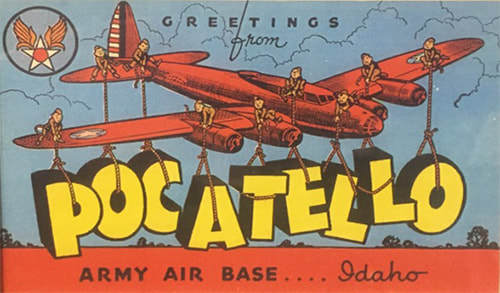
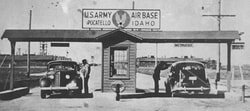
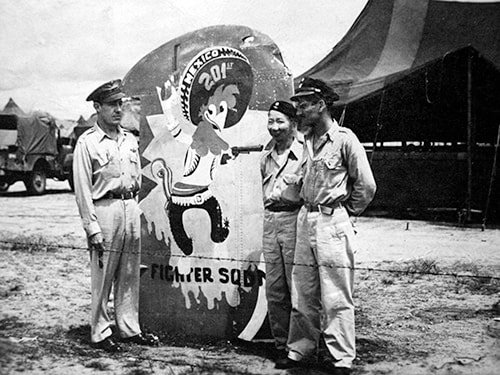
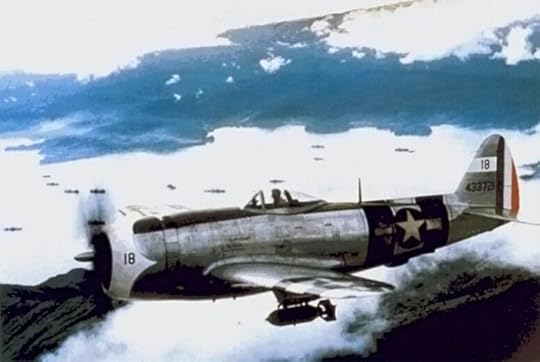
Gowen Field and Mountain Home were airbases during World War II, but so was Army Airbase Pocatello. The Pocatello Regional Airport is located on the site of the old base. That’s where the Mexican Air Force trained.
Wait. What? Yes, Mexico declared war on Germany on May 28, 1942. In 1944 the Mexican government offered an Air Force squadron to President Roosevelt to support the war effort in the Pacific. That’s when the 201st Mexican Expeditionary Air Force Squadron of Mexico moved to the U.S. for training.
The squadron called themselves Aztec Eagles. They trained first at Randolph Field in San Antonio, where they were given medical exams and received testing for flight and weapons proficiency. Next, the squadron went to the army base at Pocatello to receive specialty training in each man’s area of expertise, such as armament, communication, or engineering. They finished their training at Gunnery School at Harlingen, Texas.
Thirty-eight pilots and more than 300 support personnel from the Mexican Expeditionary Air Force flew into Pocatello for three months of training in 1944. The Mexicans were surprised to meet female pilots while they were there. The Women Airforce Service Pilots (WASPs) shuttled airplanes from one base to another. The Mexican Air Force had no equivalent, but they soon learned to respect the skills of the women.
The Aztec Eagles joined the war effort in the Philippines in June, 1945 as part of MacArthur’s promised return. They flew 96 combat missions, dropping some 1500 bombs on Luzon and Formosa, helping to drive the Japanese from those islands.
While fighting in the Philippines the Aztec Eagles lost five pilots, three who ran out of fuel over the ocean, one who crashed, and one who was shot down.
In November 1945, the Aztec Eagles returned to Mexico and were welcomed home with a military parade, honoring the first Mexican troops to ever participate in military combat overseas.




Published on August 09, 2022 04:00



